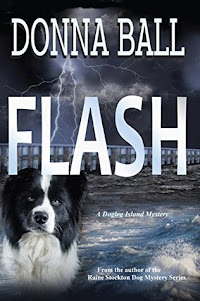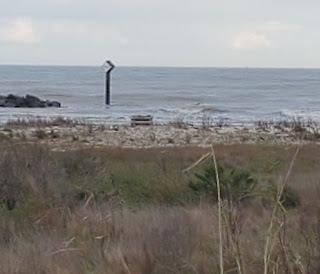Friday, February 5
Leaving day at last. On the previous night we'd taken the RV over to the dump station--excuse me, "holding tank disposal facility"--and dumped, then returned to our spot and parked a few yards further up so Ed could put the car back on the tow dolly. If we'd known we weren't going to use the car, we could have left it hooked up the whole time. The spaces are absurdly long.
Google maps had our route as a 4:50 trip, so we wanted to get an early start. We left the park at 9:41, but remember, it takes almost 10 minutes to wind through the campground at 10 miles per hour and get to the exit.
So off we went, through the empty beach town to the long drive up Highway 1 and off the island. On the way we observed that all of the houses have names, displayed on prominent signs on a front wall. M&Ms and Go Tigers are a few of the ones I remember; wish I'd written some of them down. The names were vaguely amusing, but most were pretty dumb. I suggested that the names might be replacements for house numbers but Ed saw some numbers, too.
Of course we got behind a truck hauling some sort of road grader. No passing on the narrow road, so we followed him a long way. He wasn't going all that slow--just slow enough to be annoying. But eventually we were off the island and heading north and we had to make the decision whether to go up to I-10 and Baton Rouge, the route we'd come down on, or head due west on US-90 toward Lafayette. The US-90 route was 20 minutes faster, plus it was more interesting, so I chose it.
We knew it was going to be a long drive, and it was. Soon it began raining and it continued raining for most of the drive. Horrible. Luckily there wasn't a lot of traffic, but there was enough to make it miserable. I mean, for Ed. I wasn't driving but I wasn't exactly enjoying myself either.
Peculiar roads that lift up to let boats pass through:
Early on, when I was looking down at the map, Ed told me that there were birds all over and when I looked up, I'd missed them. On a flooded field which we were just then passing there had been thousands of birds, and overhead there were V after V of flocks heading...where? We were supposed to be traveling northwest at the time, and so they appeared to be heading southwest. In February? Possibly the road had veered a little and they were really going westward, heading toward Texas and planning to end up in the northern states somewhere.
I have no idea what they were. Big, and flying in Vs.
The road became four lane, limited access with wide shoulders; the signs indicated it was the "future corridor of I-49". But just as I was getting comfortable (as a passenger, of course, I should always be comfortable. But when you're looking down at your lap reading the map or the birdbook or something and then you glance up and see brakes lights glaring in your face, it makes even a passenger a little jumpy.)
Anyway, just as I was getting comfortable, the road went through some little development or other and suddenly there were cars turning and cars crossing and buildings all over. And repeat. And repeat. And then we got into Lafayette.
Wow. I don't see how this road could ever become a "corridor" since it goes right through the heart of a crummy part of town, with some very old houses and junky stores. There are six very narrow lanes, no median, and stoplights galore. The houses reminded me of the ones in downtown Paducah, where I grew up. Most likely they were built in the 1940s or so, little one-bedroom shacks with asphalt siding and tiny backyards.
It wasn't at all what I would have expected of a city so well-known as Lafayette, but then we obviously weren't going through the really old section or the downtown. Just one of the outer rings of a town where people crowded in after the war, happy to have a house of their own--even if that meant you could toss a softball in the air and end up hitting your neighbor's windows. Just like where I grew up.
Eventually we were on I-49 and moving rapidly, and then we had to stop. It was just a truck stop, a Love's, where we did a quick fill-up at the truck pumps. Ed would prefer to use the car pumps but they were too short and crowded. Even the truck pumps were really busy, in fact, the truck driver who pulled in behind us got tired of waiting while Ed was spending ten minutes topping off the tank to the very brim. He backed up and moved to another spot. I didn't think big trucks could do that, but he sure did. Maybe they have backup cameras nowadays.
Add to notes: Love's travel stops have dog parks. We didn't use the dog park this time because the dogs had just gotten a walk at the I-49 Rest Area a half-hour before.
It was a quick trip down narrow, but very driveable roads to Colfax RV Park. It's an odd place. According to the man at the gate, it was built by the Corp of Engineers for the River Authority who now own and manage it. It's very pleasant but tiny, with a barely navigable street in a loop through two rows of RV sites fronting an offshoot of the Red River. It appears that the river split at this point and the COE put up a dam on one of the sides, making a little pocket of water for boat parking.
The RV sites are really close together (note to self, write a review of this place) but nice and long with 50-amp power, water hookup and, in our site, sewer. Very nice sites but not much room around them. Cramped.
We're situated such that our door and picnic table have no view of the river--it's blocked by the Mammoth's bulky side--but our other window has a nice view of the boat ramp. Lovely sarcasm, did you get it?
The sunset was glorious in clouds. Did I mention it stopped raining? Just after we took in fuel, a line of sky appeared to the west and the clouds disappeared behind us.
We arrived at at 2:58 but checking in took a horrible long time. It appeared that my reservation had only held the site, not paid for it. When I walked back to the RV to get my wallet, two trucks with trailers pulled in behind us and the drivers of the trailers walked up to the window and got waited on first. I wasn't angry--it made sense to get them moving while I was off getting my wallet, but I wasn't happy about waiting ten minutes or more with the engine running and the poor dogs stuck inside.
We weren't parked and unloaded until 3:55.
-------------- review ----------------
Colfax RV Park
$32/night but half off with America the Beautiful/Golden Age passport
Very nice, but cramped. We had a full hookup site on the row by the boat ramp. Although our picnic table's view was blocked by the RV body, the back windows had nice views of the Red River diversion channel--past the parking lot and through the electric wires. So it's not exactly scenic, but perfectly adequate as a stop-off from places east to places west. Or if you bring a boat, more than adequate.
Inside roads are good but very narrow--our 32-foot RV with toad went around okay, but if we had been any longer, we'd have had to cut across grass at the turns. The driveways are very long but very narrow and they don't want you to put out a mat in front of your door. (Kills the grass). So we had to step up and down on wet grass to get in and out. No biggy, but annoying. Their site drainage is excellent; despite two days of rain there were no big puddles anywhere. A few scattered trees but not much shade; it would be hot and muggy here in summer.
The park is very well maintained and very clean. Didn't need the restrooms. Supposedly free washer/dryers--didn't check. Free, but slow, Wi-Fi. There is a recreation hall but there was a wedding going on so I didn't go inside. The boat ramp is a dream, with about 22 berths and electric hookups. Fish cleaning station with electricity.
If only the driveways and road had been a few feet wider, sites a little larger, and covers over the picnic tables, I'd call the facilities excellent.
We were there on a weekend and there was a loud party across from us, late into the night. (Went to bed at 11pm and turned on the noise-blocking fan to shut it out) Luckily, no music and no car engines or such--just people hanging out, getting drunk and whooping it up. During the day it was quiet with families and small children. Nice grassy areas for kids to play ball on. There were a few unleashed dogs and a lot of people parking on the grass despite empty parking nearby. Not a problem for us but it suggests that if rules aren't being enforced, it might be unpleasant to be here during summer and on holiday weekends. Unless, of course, you're the one hosting the party.


















































